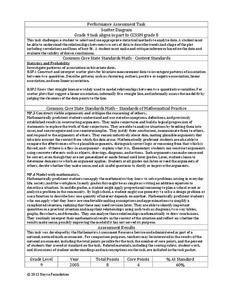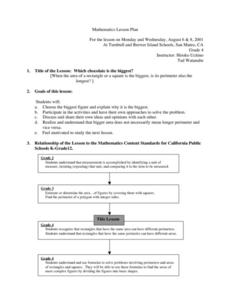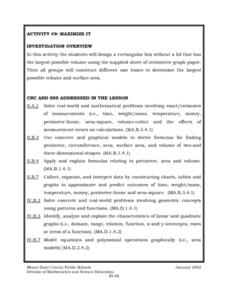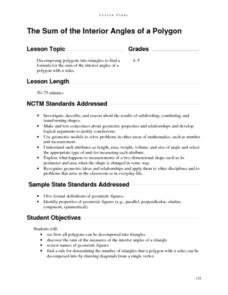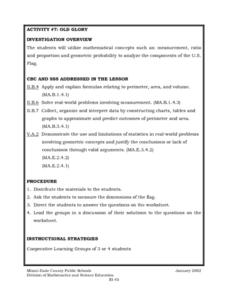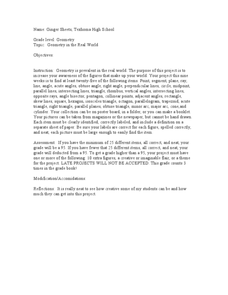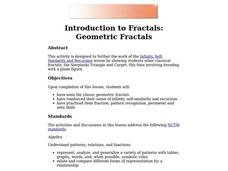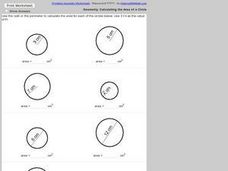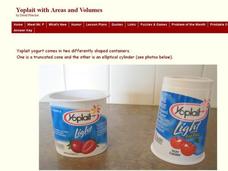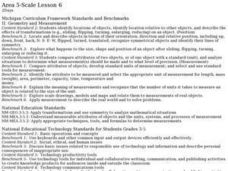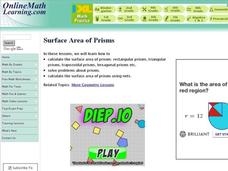Radford University
A Change in the Weather
Explore the power of mathematics through this two-week statistics unit. Pupils learn about several climate-related issues and complete surveys that communicate their perceptions. They graph both univariate and bivariate data and use...
Inside Mathematics
Scatter Diagram
It is positive that how one performs on the first test relates to their performance on the second test. The three-question assessment has class members read and analyze a scatter plot of test scores. They must determine whether...
Virginia Department of Education
Linear Curve of Best Fit
Is foot length to forearm length a linear association? The class collects data of fellow scholars' foot length and the length of their forearms. They plot the data and find a line of best fit. Using that line, they make predictions of...
Curated OER
Drawing to Scale
Students examine the process of drawing a picture to scale. They analyze and discuss real-life blueprints for a house, and create a scale drawing of an original invention using calculators and rulers.
Curated OER
Volume and Surface Area
Students explore volume and surface area. In this math activity, students fill boxes with cubes to identify the volume of the boxes. Students discuss area.
Curated OER
Which Chocolate Is The Biggest?
Students investigate the concepts of area and perimeter with the use of chocolate bars. They calculate the perimeter and area of different size rectangle chocolate bars and record the statistics. Then students make a visual comparison...
Curated OER
Maximize It!
Students design a rectangular box without a lid that has the largest possible volume using the supplied sheet of centimeter graph paper. They work in groups to construct different size boxes to determine the largest possible volume and...
Shodor Education Foundation
Volume of Prisms
Explore the concept of volume of prisms using an applet to perform the calculations. The link to the interactive applet is embedded into the lesson plan as well as a link to associated data sheets. Get your math class to the computer lab...
Improving Measurement and Geometry in Elementary Schools
The Sum of the Interior Angles of a Polygon
Junior geometers discover that polygons can be decomposed into triangles and that the number of triangles can be determined by a rule. Note that the Geometer’s Sketchpad® software is required to carry out all components of this...
Curated OER
Finding Circumference and Area of a Circle
Young geometers explore the concept of circumference and area of circles. They discuss what information is needed to find circumference and area. The resource employs several instructional methods: Frayer Model for Vocabulary, literature...
Curated OER
Old Glory
Students utilize mathematical concepts such as: measurement, ratio and proportion and geometric probability to analyze the components of the U.S. Flag. They collect, organize and interpret data by constructing charts, tables and graphs...
Curated OER
Peter's Second String
Fifth graders determine the maximum area and range of areas of a rectangle with a given perimeter. They discuss a word problem involving perimeter and area as a class, investigate the word problem using a piece of string, and in small...
Curated OER
Geometry in the Real World
Eighth graders complete a unit of lessons on basic geometry concepts. They participate in a variety of activities, culminating in a project that involves publishing a booklet or a poster that presents the major geometry concepts from the...
Curated OER
Who Wants to Carry a Million?
Young scholars, in groups, determine the volume of a box large enough to hold a million dollars. They calculate the dimensions of a bill and the volume of the money.
Curated OER
Introduction to Fractals: Geometric Fractals
Students study and observe the patterns made by the areas of the Sierpinski Triangle. Students use the computer to draw two or three iterations to discover the number patterns. Students complete worksheets based on Geometric Fractals.
Curated OER
Geometry: Calculating the Area of a Circle
In this area worksheet, learners use the perimeter or radius to determine the area of a circle. This one-page worksheet contains 8 problems. This worksheet may be produced in printed form. Answers may be viewed on-line.
Curated OER
Yoplait with Areas and Volumes
For this areas and volumes worksheet, students find the area of truncated cones and elliptical cylinders. They find the area by using one of three methods: the disk method, the shell method, and using geometry. This...
Curated OER
Scaled Rubber Band Drawings
Learners demonstrate the process of creating a scaled rubber band enlargement of a simple drawing. They observe and discuss a teacher-led demonstration, and create a scaled rubber band enlargement of simple drawings and their invention...
Curated OER
Symmetry in Paper Airplanes
Students explore symmetry. In this geometry and scientific inquiry lesson, students design paper airplanes with middle line symmetry, as well as right, obtuse, and acute angles. Students measure the plane's angles using a...
Curated OER
Fun With Adhesives
Students observe, measure, and record the properties in making objects stick together using science tools. In this science lesson plan, students explore with their senses while mixing flour and water. Additionally, students share their...
Curated OER
Surface Area of Prism
Tenth graders are provided instructions, including a video, on calculating the surface area of a prism. The one-page interactive activity contains two worked questions. Answers are included.
Curated OER
Area, Perimeter Word Puzzle
Students measure planes and solids. In this geometry instructional activity, students find the area and perimeter of different polygons.They complete a word puzzle to review their vocabulary words.
Curated OER
Surface area of a cube
In this surface area of a cube worksheet, students answer short answer questions on how to find the surface area and calculating the equation for different problems. Students answer 7 questions.
Curated OER
Geometry Review Quiz
Students conduct a review that is done right before having a geometry quiz. They cover major topics that are part of the assessment. They use review cards as notes to pass to one another to reinforce the concepts before putting them away...

